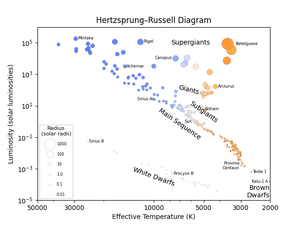Glossarbegriffe: Brauner Zwerg
Description: Ein Brauner Zwerg ist ein Objekt mit zu geringer Masse, um ein Stern zu sein, aber mit zu großer Masse, um ein Planet zu sein. Sterne werden durch die Kernfusion von Wasserstoff zu Helium in ihren Kernen angetrieben. Braune Zwerge haben eine zu niedrige Kerntemperatur, um eine solche Wasserstofffusion aufrechtzuerhalten. Zu Beginn ihres Lebens können Braune Zwerge jedoch kurzzeitig Deuterium, eine schwerere Form des Wasserstoffs, fusionieren. Diese Deuteriumfusion wird verwendet, um Braune Zwerge von Planeten zu unterscheiden, ist aber schwer zu beobachten. Braune Zwerge haben in der Regel eine Masse zwischen 1,2 % und 8 % der Sonnenmasse (etwa das 12- bis 80-fache der Jupitermasse) und sind ungefähr so groß wie der Jupiter. Junge Braune Zwerge haben in ihren äußeren Regionen ähnliche Temperaturen (effektive Temperatur) wie Sterne mit geringer Masse (Rote Zwerge). Da sie aber keine inneren Wärmequellen haben, kühlen sie mit zunehmendem Alter ab, manche sogar auf lediglich einige hundert Grad Celsius.
Zugehörige Glossarbegriffe:
- Wasserstoff
- Wasserstoffbrennen
- Jupiter
- Masse
- Planet
- Roter Zwerg
- Effektivtemperatur
- Stellare Aktivität
See this term in other languages
Term and definition status: The original definition of this term in English have been approved by a research astronomer and a teacher The translation of this term and its definition is still awaiting approval
The OAE Multilingual Glossary is a project of the IAU Office of Astronomy for Education (OAE) in collaboration with the IAU Office of Astronomy Outreach (OAO). The terms and definitions were chosen, written and reviewed by a collective effort from the OAE, the OAE Centers and Nodes, the OAE National Astronomy Education Coordinators (NAECs) and other volunteers. You can find a full list of credits here. All glossary terms and their definitions are released under a Creative Commons CC BY-4.0 license and should be credited to "IAU OAE".
If you notice a factual or translation error in this glossary term or definition then please get in touch.
Related Diagrams
Hertzsprung-Russell diagram
Bildnachweis: IAU OAE/Niall Deacon
License: CC-BY-4.0 Creative Commons Namensnennung 4.0 International (CC BY 4.0) icons









